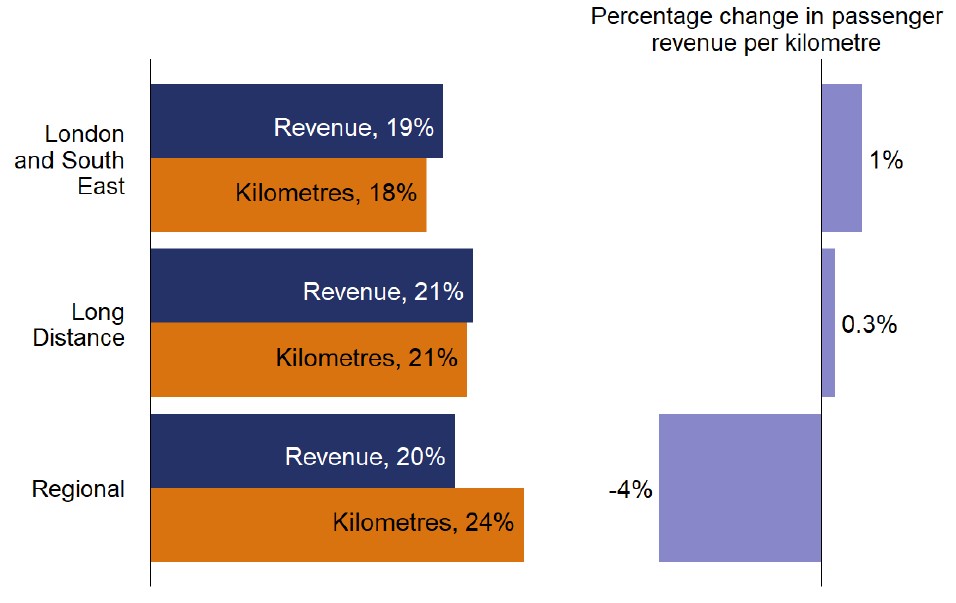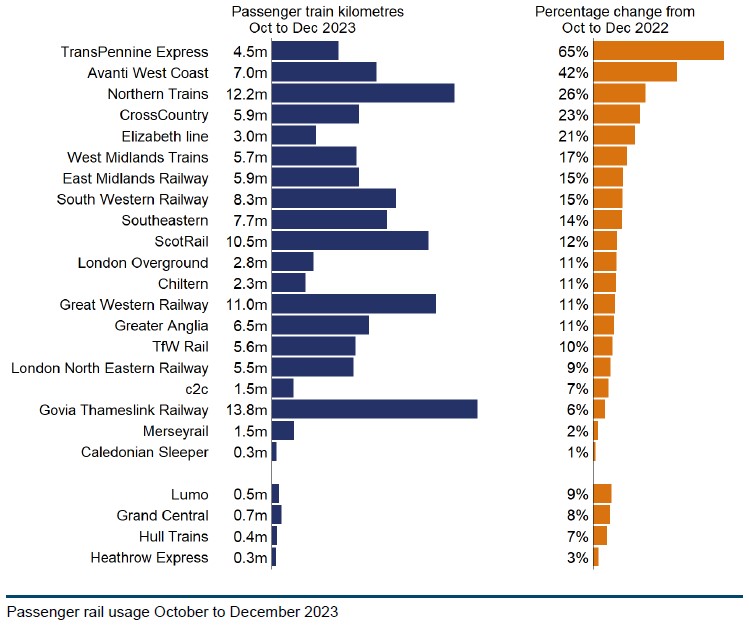A total of 417 million rail passenger journeys were recorded in Great Britain between October and December 2023, according to the Office of Road and Rail (ORR).
The organisation’s report ‘Passenger rail usage October to December 2023’ shows a 20% increase on the 348 million journeys in the same quarter of 2022. This mirrors the percentage increase for rail journeys for the year January 2022 to December 2023, which saw 1,570 million journeys.
According to the ORR’s report, a total of 15.2 billion passenger kilometres were travelled in Great Britain in Oct-Dec 2023, and total passenger revenue for the quarter was £2.6 billion.
These figures continue to show a rising trend in the recovery from the pandemic lockdowns although the number remains lower than pre-lockdown levels, at 90% of the 461 million in Oct-Dec 2019.
Passenger journeys
The report shows that all train operators enjoyed a greater number of passenger journeys. This was due to fewer strike days impacting passenger services than during the same period in 2022.
Elizabeth line saw the largest increase in journeys, which were up by 40%, driven in part by the increased number of services following the opening of the central section of the line.

Transpennine Express and Avanti West Coast both planned at least 40% more trains compared with the reduced timetables in Oct-Dec 2022, resulting in a large increase in passenger journeys. ScotRail saw a 34% increase compared with the previous year, but only a 12% increase in trains planned. Heathrow Express saw the smallest increase in passenger journeys at 5%, followed by c2c and London North Eastern Railway, both up 6%.
Open access operators recorded 2.3 million passenger journeys combined, an increase of 14% on the 2.0 million in the same quarter of 2022.
The report also broke down the statistics by sector. The London and South East sector recorded 293 million journeys in the latest quarter, making it the largest sector. This was a 19% increase on the 245 million journeys in the same quarter in the previous year. The Long Distance sector recorded 34.8 million journeys, an increase of 21%, while the Regional sector recorded 87.7 million journeys, up 22% Oct-Dec 2023.
Passenger kilometres
Just over 15 billion passenger kilometres were travelled in Oct-Dec 2023, a 20% increase compared on the previous year. Again, this remains lower than pre-lockdown levels.
All operators saw a greater number of kilometres travelled during the period. Elizabeth line recorded the largest increase (up 43%), and the smallest increases were shown by Heathrow Express (5%), London North Eastern Railway (6%), and c2c (8%).
Avanti West Coast and Transpennine Express ran reduced timetables in the previous year, which caused a large increase in passenger kilometres compared with Oct-Dec 2022 (both up 39%).
Of the open access operators, Hull Trains, Grand Central, and Lumo, all saw large increases in kilometres travelled (between 23% and 28%).
The London and South East sector recorded 293 million journeys, making it the largest sector. This was a 19% increase on the 245 million journeys in the same quarter in the previous year. The Long Distance sector recorded 34.8 million journeys, an increase of 21%, and the Regional sector recorded 87.7 million journeys, a 22% increase on Oct-Dec 2023.
Passenger revenue
Total passenger revenue in Great Britain was £2.6 billion in Oct-Dec 2023. Adjusted for inflation, this was 20% more than the £2.2 billion generated in the same quarter in the previous year. Again, this remains below pre-lockdown levels, at 79% relative to the £3.3 billion in the same quarter in 2019.
Passenger revenue per journey was £6.27, a slight decrease compared with the £6.28 in the same quarter in the previous year. Passenger revenue per kilometre was 17.2 pence, slightly lower than the 17.3 pence in the previous year.

With a total revenue of £1.3 billion, London and South East remained the largest sector in the latest quarter, though of the three sectors, it recorded the smallest increase in revenue (up 19% on the £1.1 billion in the previous year). The Long Distance sector showed the largest growth with £839 million of revenue in the latest quarter compared with the £694 million in the previous year, up 21%.
A total of £2.3 billion was generated across all ordinary fare tickets, compared with the £2.0 billion in the same quarter in the previous year. Of these, Advance tickets saw the largest increases (up 26%). Off-Peak tickets saw the smallest percentage increase (up 15%), with £1.0 million in the latest quarter compared with £897 million in the previous year. Season tickets also generated more revenue in the latest quarter, with £208 million compared with £185 million in the same quarter the previous year (up 13%).
Overall, the change in revenue per kilometre was relatively small across all ordinary fareticket types. Anytime or Peak tickets showed a slight decrease (down 1%), Off-Peak tickets showed a slight increase (up 1%), and Advance tickets showed the least change (up 0.3%). However, season tickets showed a larger change (up 5%).
Train and vehicle kilometres
According to the report, Oct-Dec 2023 saw 123 million passenger train kilometres travelled – a 16% increase on the 106 million recorded in the same quarter in the previous year. Passenger train kilometres include only the distance covered by the train itself and so does not account for the number of carriages.
TransPennine Express (up 65%) and Avanti West Coast (up 42%) recorded the largest due to reduced timetables being operated in the previous year. No operators recorded fewer passenger train kilometres compared with the previous year, due to more strike action in the previous year.
Passenger vehicle kilometres (for locomotive hauled trains this includes the distance travelled by the locomotive) also saw a sizeable increase, with 750 million passenger vehicle kilometres operated in Oct-Dec 2023. This is a 13% increase on the 663 million kilometres in the same quarter in the previous year. However, it remains below pre-lockdown levels, at 92% relative to the 816 million seen in Oct-Dec 2019.
Only c2c and Caledonian Sleeper saw a reduction in vehicle kilometres operated, down 2% and 1%, respectively. TransPennine Express, (up 60%), recorded the largest increase. All open access operators saw an increase, with Grand Central and Hull Trains showing the largest increases (both up 8%).

Industry response
The report clearly represents a step in the right direction for the industry, but reaction has been mixed. Industry bodies remain concerned that passenger numbers have not yet reached pre-lockdown levels, and that the lack of any long-term strategy will stymy further growth.
A spokesperson for Rail Partners said: “Although the latest ORR data shows an increase in passenger numbers, passengers are still not using trains at the levels seen before the pandemic lockdowns.
“This underlines the urgent need for rail reform to create a new public body to oversee the railways, but also to give operators the commercial freedoms to attract customers back to rail.
“Increasing passenger numbers will grow revenues, reduce taxpayer support, encourage modal shift and help Britain to reach net zero.”
Darren Caplan, chief executive of the Rail Industry Association (RIA) commented: “The return to rail continues apace and this substantial 20% uplift year-on-year is a really encouraging increase in the number of passenger journeys and revenues.
“These new ORR and DfT figures are a reminder that the railway will need more capacity in the future, especially with the recent RIA-commissioned Steer report forecasting passenger numbers to grow between 37% and 97% to 2050, depending on which policy levers the UK Government adopts in the coming years.
It is clear that there needs to be rail reform and a long-term rail strategy, including a plan for more capacity, to deliver the connectivity, economic, levelling-up, and sustainability benefits everyone wants to see.”
The full report can be viewed at: https://dataportal.orr.gov.uk/media/v1ilmjut/passenger-rail-usage-oct-dec-2023.pdf
Lead image credit: iStockphoto.com

